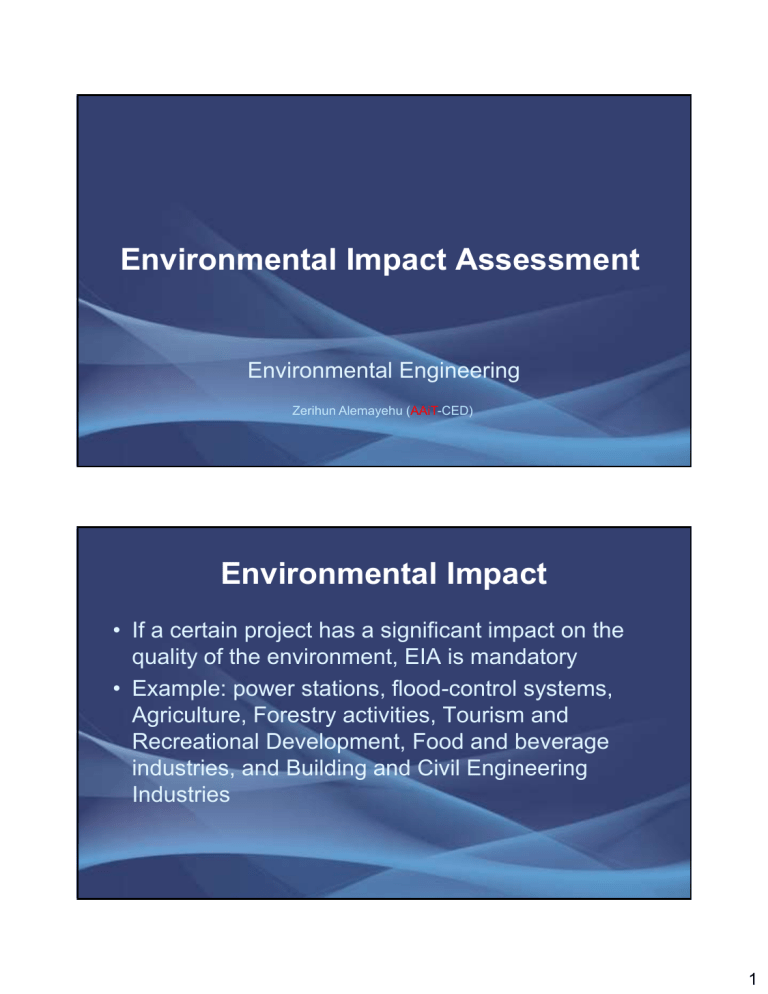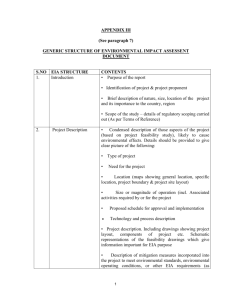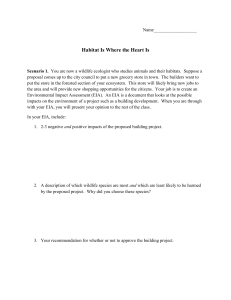
Environmental Impact Assessment Environmental Engineering Zerihun Alemayehu (AAiT-CED) Environmental Impact • If a certain project has a significant impact on the quality of the environment, EIA is mandatory • Example: power stations, flood-control systems, Agriculture, Forestry activities, Tourism and Recreational Development, Food and beverage industries, and Building and Civil Engineering Industries 1 What is an EIA? An environmental impact assessment (EIA) is an activity designed to identify and predict the impact on the biogeophysical environment and on human health and well-being, of legislative proposals, policies, programs, projects and operational procedures, and to interpret and communicate information about the impact. What is an EIA? Environmental Assessment: The methodology of identifying and evaluating in advance, any impact positive or negative, which results from the implementation of a proposed action. (Ethiopia EPA) 2 What is it really? Environmental Impact Assessment is a process, set down as a repeatable series of steps to be taken, to allow the environmental consequences of a proposed development to be assessed. The environmental consequences have to be those INCREMENTAL effects which are due to the proposed development, and not those which are due to the passage of time or other developments not included in the proposal. Screening (does the project require Impact assessment (interpreting EIA?) the impacts) Scoping (what issues and impacts Mitigation (what can be done to should the EIA address?) alleviate negative impacts?) Baseline studies (establish the EIS preparation/review environmental baseline) (document the EIA findings) Alternatives (consider the different Public consultation (consult approaches) general public and NGOs) Impact prediction (forecast the Monitoring (monitor impacts of environmental impacts) project) 3 Screening • Is an EIA needed? • Many projects may have no significant environmental effects • A screening mechanism seeks to identify those projects with potentially significant adverse environmental effects Screening • Criteria used include – size of project, nature of project and sensitivity of the environment. • The outcome of screening could be one of the following: – No EA required – Preliminary Assessment (PA) – preliminary assessment is applied to: • Projects with limited impacts, • Projects in which the need of EA is unclear, and • Proposals with inadequate information – Full scale EA – when there is sufficient ground for detail assessment. 4 Scoping • The scope of an EIA is the issues and impacts it addresses • Scoping is the process of deciding which of a project’s possible alternatives and impacts should be addressed in the EIA • An EIA should focus only on the significant issues and impacts Scoping • Scoping is carried out in discussions between the developer, the competent authority, relevant agencies and, ideally, the public • Effective scoping enables limited resources to be allocated to best effect (i.e. through investigation of only the most significant impacts) 5 Baseline studies • Assemble relevant information on the current status of the environment • Should anticipate the future state of the environment assuming the project is not undertaken - the ‘no action alternative’ • This provides the ‘baseline’ against which future impacts can be assessed Alternatives • EIA is ideally undertaken for a project and its alternatives (e.g. different locations, scales, designs) • Alternatives are the ‘raw material’ of EIA • the discussion of alternatives as the ‘heart’ of the EIS • Many EISs fail to consider alternatives 6 Impact assessment • involves evaluating the significance of the impacts identified • Significance can be determined through professional judgement, reference to regulations etc. • Potential for bias in determining what is significant • Can ultimately be used by decision-makers when determining the fate of the project application Impact assessment • Semi-quantitative approaches: – checklist, – the interaction matrix, and – the checklist with weighted rankings. 7 Impact assessment: Checklists • Checklists:lists of potential environmental impacts, both primary and secondary. • Primary effects :as a direct result of the proposed project, such as the effect of a dam on aquatic life. • Secondary effects : an indirect result of the action. For example, an interchange for a highway may not directly affect wildlife, but indirectly it will draw such establishments as service stations and quick food stores, thus changing land use patterns. Impact assessment: Checklists • The checklist technique lists all of the pertinent factors; then the magnitude and importance of the impacts are estimated. • May be quantified by establishing an arbitrary scale, such as: 0 = no impact 1 = minimal impact 2 = small impact 3 = moderate impact 4 = significant impact 5 = severe impact 8 Impact assessment: Interaction matrix • Two-dimensional listing of existing characteristics and conditions of the environment and detailed proposed actions that may affect the environment. • The interactions are measured in terms of magnitude and importance. • The magnitudes represent the extent of the interaction between the environmental characteristics and the proposed actions and typically may be measured. • The importance is often a judgment part of the engineer. Example • A landfill is to be placed in the floodplain of a river. Estimate the impact by using the checklist technique. Potential Impact Importance x Magnitude Groundwater contamination 5 x 5 = 25 Surface water contamination 4 x 3 = 12 Odor 1x1=1 Noise 1x2=2 Total 40 This total of 40 may then be compared with totals calculated for alternative courses of action. 9 Example • Lignite (brown) coal is to be surface-mined in the Appalachian Mountains. Construct an interaction matrix for the water resources (environmental characteristics) vs resource extraction (proposed actions). 10 Mitigation • Negative impacts on the environment identified during the EIA can be alleviated through mitigation measures • The mitigation hierarchy: Avoid - Reduce Remedy - Compensate - Enhance • residual impacts: Impacts remaining after mitigation EIS preparation / review • The Environmental Impact Statement (EIS) is a formal document which includes information on the development and information relating to screening, scoping, baseline studies, alternatives etc. • Common requirement to include a non-technical summary 11 EIS preparation / review • Once complete, the EIS is submitted to the competent authority (along with the planning application) • The EIS is often reviewed (either formally or informally) • The review enables the competent authority to decide whether the EIA is adequate, accurate and unbiased Public consultation • The EIA provides for public consultation on the application for development and the EIS 12 Post-project monitoring • Monitoring should determine: – the accuracy of the original predictions – the degree of deviation from the predictions – the possible reasons for any deviations – the extent to which mitigation measures have achieved their objectives What is in an EIS? • • • • • • Non Technical Summary Description of the proposals Assessment of Baseline conditions Assessment of no development conditions Assessment of conditions with development Mitigation proposals 13 What is in an EIS? All conditions assessed for • Construction phase • Operation phase Construction Phase • • • • • Temporary Higher levels of impact usually deemed acceptable Difficult to predict VERY difficult to enforce conditions Usually well influenced by effective consultation 14 Operation Phase • • • • Long Term Much less room for compromise on standards Relatively simpler to predict Less difficult to enforce conditions, as the conditions are on the project owner • Usually less influenced by effective consultation at scheme level, more at detailed level Operation Phase • Can be several phases • Project itself may be developed in stages • Sometimes need to look at – – – – – – Commissioning Opening Operation after period Operation once landscaping mature Operation at design capacity Operation at ultimate capacity 15

